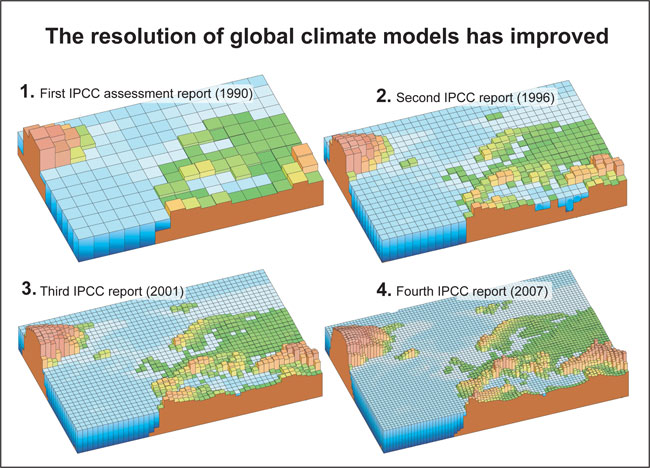Global climate models are undergoing continuous change with rapidly advancing technology. Extensive memory and strong processing power are two important factors that inhibit complex climate numerical modeling. Additionally, in order to accurately replicate climatic processes, sophisticated knowledge of these processes is essential. As these two factors continue to develop, so too does the precision, complexity and accuracy of global climate models. These models have an extensive history, beginning in the evolution of computing machines, with widespread progress within the last two decades (AIP, 2013).
The inner workings of climatic processes were vastly unknown until the mid 20th century, with ground level observations increasing throughout World War II. Mapping and large-scale circulation hypothesis commenced at this time -- a mathematical conclusion was still unidentified. The concept of splitting the Earth’s climate system into a manageable grid was proposed by Lewis Fry Richardson in 1922; observations of air temperature, pressure, wind dynamics and other factors were implemented in physics equations. However, the complexity of the mathematic equations were beyond the level of technology available. The slow process of employing numerous clerks to calculate these climatic patterns would not compare to the speed in which the weather occurs. Following little success, the idea of numerically modeling weather was abandoned. A few decades later, with simplified equations, the circulation was modeled, but at very coarse resolution with very little accuracy (AIP, 2013).

system developed for nuclear weapons modelling, later
used for numerical meteorological modelling.
John von Neumann implemented the first true numerical meteorological model using World War II technology in 1946. He applied non-linear fluid dynamic equations originally used to simulate nuclear weapons using ENIAC (Figure 1), the first general purpose computing system. Finally, the age of computer simulation of climate commenced. The first accurate climate model from John von Neumann’s team utilized a two-dimensional space with 700km resolution over 250 points along a simple grid. With this technology, weather was occurring at the same rate as they were able to compute it. At around the same time, the Royal Swedish Air Force Weather Service, out of the University of Stockholm was able to predict weather three days ahead. Although the Swedish modeling was temporally advanced, they lacked accuracy. Unfortunately, in both cases many rudimentary weather processes were incorrected assumed by lack of observational knowledge (AIP, 2013; University of Pennsylvania, 2013).
Norman Phillips advanced the global climate model by developing a two-layer atmospheric numerical model at Princeton University. He used cylindrical shaped units with 16 grid circumference and 17 grid height, resulting in a true jet stream prediction. The next advancement, into three-dimensional modeling occurred at the Washington U.S. Weather Bureau by 1965. Although the accuracy of these models was enhanced, topographical factors were largely ignored. In the early 1970s, James Hansen implemented cloud physics and albedos into existing model framework and models began interpreting Earth based on its latitudinal spheres (AIP, 2013).

to present.
The first true modeling of climate change occurred in the mid 1970s (Figure 2), when scientists began to realize and interpret increasing atmospheric CO2. Additionally, a model from Manabe and Wetherald estimated an enhanced warming effect in the Arctic at this time. As satellite technology developed, so too did the accuracy of climate models. More precise climate models were initiated in the 1980s, as scientists initiated the implementation of geographical features into the numerical simulations. A high degree of success came from the work of the NCAR, community climate model project in Australia. This group shared model code internationally, to aid in improvement of climate modeling output. Individual research groups added new improved numerical models such as the hydrological cycle. This shared network of knowledge improved the model extensively, with new releases continuing through the next two decades (AIP, 2013).

IPCC through time between 1990-2007.
The continued knowledge produced from community climate models influenced the examination and publication of climate change by the IPCC (International Panel on Climate Change). The unambiguous greenhouse effect was a widespread modeled phenomenon by 2005. With the influence of the IPCC, global climate models have advanced in realism and resolution (Figure 3). This effect of continued development of climate models is expected in the future with impending climate change (IPCC, 2007; AIP, 2013).
References
Climate Modelling Links
Material on this page was provided by Maren Pauly, Department of Geography, University of Waterloo.
